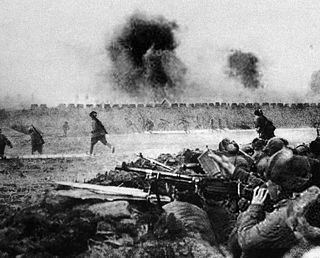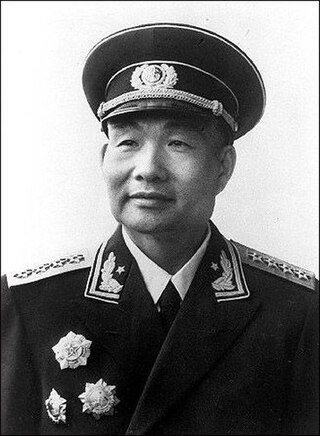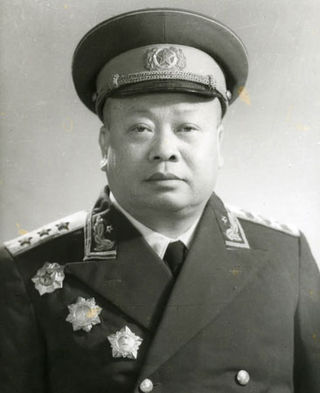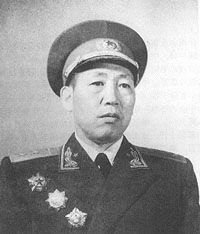
The Chinese Civil War was fought between the Kuomintang-led government of the Republic of China and the forces of the Chinese Communist Party (CCP), with armed conflict continuing intermittently from 1 August 1927 until 7 December 1949, resulting in a CCP victory and control of mainland China in the Chinese Communist Revolution.

Xu Xiangqian was a Marshal of the People's Republic of China (PRC). He was the son of a wealthy landowner, but joined the Kuomintang's (KMT) National Revolutionary Army (NRA), against his parents' wishes, in 1924. When the Chinese Civil War started in 1927, Xu joined the Eyuwan Soviet led by Zhang Guotao; Xu became commander of the Eyuwan-based Fourth Red Army. Zhang and Xu retreated to northern Sichuan after being defeated by a KMT encirclement campaign. Xu politically survived Zhang's defection to the KMT in the late-1930s; he rejoined the Red Army in a less senior position under the leadership of Mao Zedong.

Su Yu, Courtesy name Yu (裕) was a Chinese military commander, a general of the People's Liberation Army. He was considered by Mao Zedong to be among the best commanders of the PLA, only next to Peng Dehuai, Lin Biao and Liu Bocheng. Su Yu fought in the Second Sino-Japanese War and in the Chinese Civil War. He commanded the East China Field Army during the Chinese Civil War. His most notable accomplishments were the Battle of Menglianggu, the Battle of Huaihai, the Yangtze River crossing, and the capture of Shanghai.

The Liaoshen campaign, an abbreviation of Liaoning–Shenyang campaign after the province of Liaoning and its Yuan directly administered capital city Shenyang, was the first of the three major military campaigns launched by the Communist People's Liberation Army (PLA) against the Kuomintang Nationalist government during the late stage of the Chinese Civil War. This engagement is also known to the Kuomintang as the Liaohsi campaign, and took place between September and November 1948, lasting a total of 52 days. The campaign ended after the Nationalist forces suffered sweeping defeats across Manchuria, losing the major cities of Jinzhou, Changchun, and eventually Shenyang in the process, leading to the capture of the whole of Manchuria by the Communist forces. The victory of the campaign resulted in the Communists achieving a strategic numerical advantage over the Nationalists for the first time in its history.

Tao Zhiyue was a Chinese military officer and politician, lieutenant general of the National Revolutionary Army of the Republic of China, and a full general of the People's Liberation Army of the People's Republic of China.

Chen Xilian was a Chinese military officer and politician, general of the People's Liberation Army. A prominent Maoist, he held very important positions in both military and political spheres.

Liu Yalou was a general in the Chinese People's Liberation Army who served as the inaugural commander-in-chief of the PLA Air Force. During the Chinese Civil War, he was chief of staff of Lin Biao's army group, which occupied the entirety of Manchuria in 1948 and captured 472,000 Kuomintang troops in the Liaoshen Campaign.

The territory of the People's Republic of China (PRC) has frequently been revised since its formation on 1 October 1949.

Communist-controlled China or the Revolutionary Base Area, officially called the Soviet Zone from 1927 to 1937, and the Liberated Zone from 1946 to 1949, was the part of the territories of China controlled by the Soviet-backed Chinese Communist Party (CCP) from 1927 to 1949 during the Republican era and the Chinese Civil War with Nationalist China.

Xiao Jinguang was a revolutionary and military leader, one of the main leaders of the Red Army and the People's Liberation Army, and one of the ten senior flag officers of the PLA and the only Fleet Admiral in PLA Navy history.

Yang Yong was a general in the People's Liberation Army of China. He served as the secretary of the Secretariat of the Chinese Communist Party between September 1982 and January 1983, and governor of Guizhou, from January 1950 to April 1951.

Li Zhimin (Chinese: 李志民 or 李凤瑞 or 李明阶; pinyin: Lǐ Zhìmín or Lǐ Fèngruì or Lǐ Míngjiē; July 9, 1906 – November 16, 1987) was a general of the People's Liberation Army from Liuyang, Hunan. Li was the former political commissar and director for the Political Department of the Chinese People's Volunteers.

Lai Chuanzhu (simplified Chinese: 赖传珠; traditional Chinese: 賴傳珠; pinyin: Lài Chuánzhū; 3 April 1910 – 24 December 1965) or Peng Ying (鹏英) was a general of the People's Liberation Army from Gan County, Jiangxi.

Chen Mingren (simplified Chinese: 陈明仁; traditional Chinese: 陳明仁; pinyin: Chén Míngrén; 7 April 1903 – 21 May 1974) was a prominent military figure from Liling, Hunan Province, and one of the founding members of the People's Liberation Army. He was a top-level military commander in the Republic of China. He then joined Communist China in 1949. Chen was awarded with the rank of general in 1955.

Wang Bingzhang was a Chinese Communist revolutionary and a founding lieutenant general of the People's Liberation Army (PLA). He joined the Northwest Army of the warlord Feng Yuxiang in 1929, before participating in the Ningdu uprising and defecting to the Communist Red Army in 1931. He fought in the Red Army's Long March, the Second Sino-Japanese War where he was credited with devising a trench warfare tactic that helped destroy enemy pillboxes, and the Chinese Civil War.

Peng Shaohui was a general in the People's Liberation Army of China, who served two separate terms as deputy commander of the People's Liberation Army, from 1954 to 1967 and from 1969 to 1978. Peng was the only fellow-villager of Mao Zedong in the People's Liberation Army. He was known as "One-Armed General".
Guo Linxiang was a general in the People's Liberation Army of China who served as political commissar of the People's Liberation Army General Logistics Department from 1973 to 1975 and political commissar of the Nanjing Military Region from 1982 to 1985.
The following is a topical outline of English Wikipedia articles about the history of the Chinese Civil War (1912–1949)
The following is a topical outline of English Wikipedia articles about the military history of the People's Republic of China. It includes the military events, individuals, and topics involving the People's Republic of China from the Chinese Civil War to the present. The events are outlined chronologically with topical subsections.

















